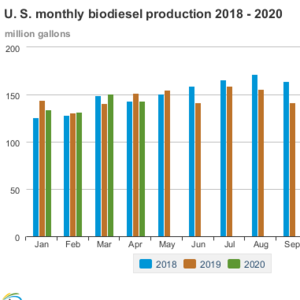US biodiesel production down slightly in April, soy oil use rises

Source: U.S. Energy Information Administration
June 30, 2020
BY Ron Kotrba
U.S. production of biodiesel fell slightly in April compared to March, according to data from the U.S. Energy Information Administration, as lockdowns from the coronavirus pandemic that began to take hold in March were expanded and held firm throughout April. Production of biodiesel in the U.S. was 151 million gallons in March, which was 19 million gallons higher than February’s production volumes, but producers dialed back biodiesel manufacturing to 143 million gallons in April.
In addition to the health and economic crisis that strengthened in April due to the coronavirus pandemic and economic fallout, the energy complex was turned upside down in April as crude oil traded at negative $37 a barrel due to a sharp drop in demand and lack of available storage. Also, many of the biodiesel plants that idled production in 2019 due to the prolonged federal tax credit lapse and plentiful small refinery waivers from U.S. EPA relieving oil companies of their obligations under the Renewable Fuel Standard had not received their retroactive tax credit refunds for 2018-’19 from the IRS until later in the month.
Advertisement
Midwestern biodiesel production accounted for 69 percent of the total U.S. production in April. Overall production came from 89 biodiesel plants with capacity of 2.5 billion gallons per year.
Producer sales of biodiesel during April included 70 million gallons sold as B100 and an additional 77 million gallons of B100 sold in biodiesel blends.
A total of 1.07 billion pounds of feedstock was used to produce biodiesel in April, with soybean oil remaining the largest feedstock consumed. Despite U.S. biodiesel production dropping by 8 million gallons in April compared to March, soybean oil use by U.S. producers grew from 656 million pounds in March to 672 million pounds in April.
Advertisement
Distillers corn oil use in April dropped to 84 million pounds from 145 million pounds in March, as more and more fuel ethanol plants generating the biodiesel feedstock from their starch fermentation and distillation processes idled during the pandemic.
Yellow grease consumption also dropped in April compared to May, as restaurants were shut down amid the health crisis and therefore less fryer oil was generated. U.S. biodiesel producers consumed 71 million pounds of yellow grease in April whereas in March this was 103 million pounds.
White grease consumption, however, grew in April compared to March. In April, white grease use by U.S. biodiesel producers was 42 million pounds whereas in March it was 36 million pounds.
Related Stories
The USDA significantly increased its estimate for 2025-’26 soybean oil use in biofuel production in its latest World Agricultural Supply and Demand Estimates report, released July 11. The outlook for soybean production was revised down.
U.S. fuel ethanol capacity fell slightly in April, while biodiesel and renewable diesel capacity held steady, according to data released by the U.S. EIA on June 30. Feedstock consumption was down when compared to the previous month.
The U.S. EPA on July 8 hosted virtual public hearing to gather input on the agency’s recently released proposed rule to set 2026 and 2027 RFS RVOs. Members of the biofuel industry were among those to offer testimony during the event.
The USDA’s Risk Management Agency is implementing multiple changes to the Camelina pilot insurance program for the 2026 and succeeding crop years. The changes will expand coverage options and provide greater flexibility for producers.
The USDA’s National Agricultural Statistics Service on June 30 released its annual Acreage report, estimating that 83.4 million acres of soybeans have been planted in the U.S. this year, down 4% when compared to 2024.
Upcoming Events










